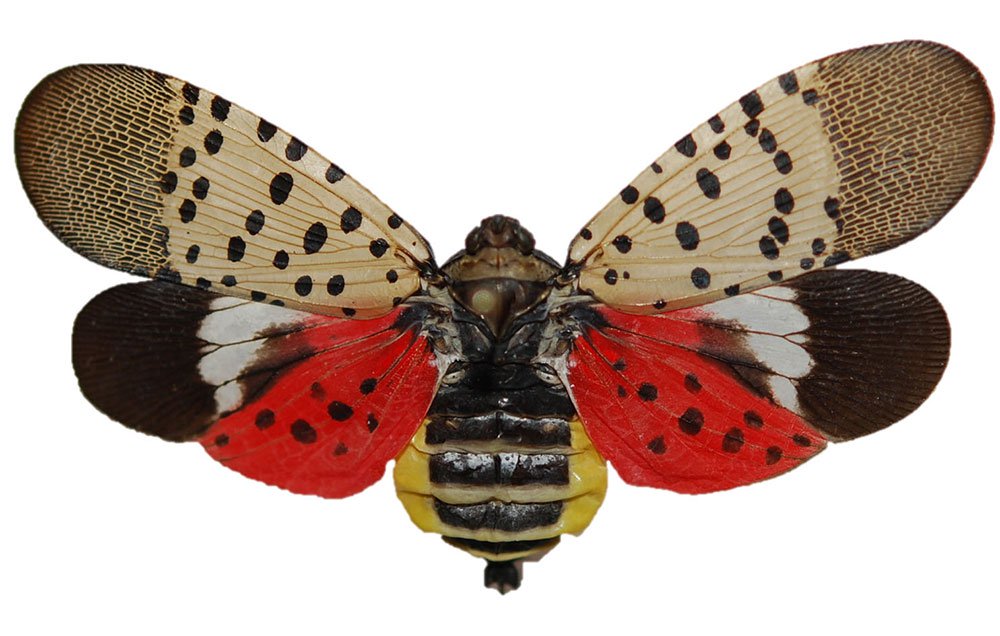
Photo by Pennsylvania Department of Agriculture
The spotted lanternfly – a destructive, invasive plant hopper – has been confirmed in New Castle County. Delaware is the second state to have found the insect which was first detected in the United States in 2014, in Berks County, PA. The spotted lanternfly has now spread to 13 Pennsylvania counties.
This insect is a potential threat to several important agricultural crops including grapes, apples, peaches, and lumber. State plant health and forestry officials are providing information, fact sheets, photographs, and links to other resources at de.gov/hitchhikerbug. Early detection is vital for the protection of Delaware businesses and agriculture.
“We have collected one spotted lanternfly female, and don’t know if this is a hitchhiker or an indicator of a population attempting to establish in Delaware. Over the winter months we will be conducting an intensive survey around the detection location, searching for egg masses. We will also be reaching out to homeowners, businesses, and communities to help identify this pest. Our goal is to keep this insect out of Delaware and away from our agricultural crops,” said Dr. Faith Kuehn, administrator of DDA’s Plant Industries Section, which oversees spotted lanternfly detection.
Delaware has been working to monitor for spotted lanternfly infestations since Pennsylvania first detected the insect. Our Plant Industries inspectors have conducted visual surveys in areas with tree of heaven, the spotted lanternfly’s host plant. With the recent expansion of Pennsylvania’s quarantine to county level and the proximity of these counties to New Castle County, our inspectors ramped up their inspections, detecting one dead spotted lanternfly in the Wilmington area.
Officials want to eradicate this pest before it spreads, but as a notorious hitchhiker, vigilance is key. Females lay egg masses in the fall on a wide variety of plants and surfaces, and die off with a hard frost. Come late April / early May, 30-50 nymphs will hatch from each egg mass, and begin to feed on a wide variety of agricultural and ornamental plants. Locating live or dead adults now, will help experts develop a map of distribution to search for egg masses so they can be destroyed. Any egg masses that are found now should be reported to the Department of Agriculture for verification and destruction.
“We know that the community will play an invaluable role in helping us detect spotted lanternfly,” said CAPS Coordinator Stephen Hauss. “As we continue our surveys, we are asking Delawareans to help us through the use of GPS technology on their cellphones and digital cameras, along with social media to help us build a map so that we can work on eradicating this pest before it decides to move.”
If you find a spotted lanternfly, there are several ways you can help the Delaware Department of Agriculture stop the #HitchHikerBug:
1. Take a picture: With the GPS function turned on your smartphone or a camera with GPS, take a photograph of any life stage (including egg masses). Upload your photograph to Facebook or Instagram, using the hashtag #HitchHikerBug. If you don’t have GPS capabilities and/or access to social media, submit the photograph via email to HitchHikerBug@state.de.us and include your name, contact information, and the address or georeference of where the photo was taken.
2. Collect a specimen: Suspected specimens of any life stage can be collected and placed in a vial or plastic zip-lock bag with the name and contact information of the collector, and turned into the Delaware Department of Agriculture CAPS program for verification. This insect is considered a threat to some crops and early detection is vital for the protection of Delaware businesses and agriculture.
3. Report a site: If you can’t take a specimen or photograph, report using the online form at de.gov/hitchhikerbug or send an email to HitchHikerBug@state.de.us or call (302) 698-4586 with a message detailing the location of the sighting and your contact information.
